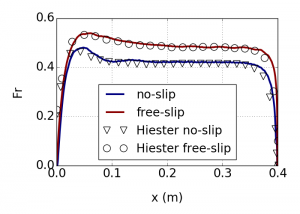Once we have verified the correctness of the implementation of CG/DG machinery, it is time to move on to more physical-like benchmarks. This time we are not able to rely on exact analytic solutions as we benchmark NUMO on a lock-exchange case, which is a standard test for non-hydrostatic ocean codes. An additional benefit of this set-up is that it can be studied experimentally. But what is the lock-exchange case exactly?
In a box of 0.8m x 0.1m x 0.1m we put two fluids side by side, one is warm and light and the other one cold and heavy. The temperature difference between them is set to 1C. To compare this set-up with other results from the literature, we use a Grasshoff number Gr=1.25e+06, which, with water viscosity of 1e-06, implies the thermal conductivity of 1e-03. We assume that there is no thermal diffusion present. We let the two fluids interact, with the difference in buoyancy of the fluids driving the flow. The movie below shows the simulation result. Note that even though we show only a 2D result, this is a full 3D simulation and we are showing only a middle plane of the solution.
[youtube https://www.youtube.com/watch?v=a9HRYwZmZKA&w=560&h=315]
The domain is bounded by a no-slip wall on the bottom, and all the other walls have free-slip condition prescribed. To compare this result with the literature, we track the velocity of the no-slip and free-slip fronts and report it as non-dimensional Froude number.

The figure shows the Froude number plotted against the distance that each front traveled. We compare this result with the simulation by Hiester et al. and see that both results match very closely, even though the simulation of Hiester is much better resolved (dx=0.00025m, while we use an effective resolution of 0.001m, but also a higher order method). Close to the initial position both fronts go through a phase of acceleration, and at x=0.4m they hit the side-walls. There is, however, a period of relative steady velocity between x=0.2m and x=0.3m, so we average the Froude number there and compare with other literature results.
| no-slip | free-slip | |
| NUMO | 0.421 | 0.482 |
| Hiester et al. (2011) | 0.417 | 0.482 |
| Fringer et al. (2007) | 0.396 | 0.428 |
| Hartel et al. (2000) | 0.406 | 0.477 |
As expected, the NUMO result matches closely recent Hiester et al. publication. However, NUMO is also very close to Hartel et al. very-high resolution DNS. This result builds our confidence in the correctness of the buoyancy effects in our code, as well as the performance of temperature (and salinity, but not featured here) transport.
So what is next? This result is an important stepping stone to a full-fledged non-hydrostatic ocean model. We are ready to move towards more realistic, non-box geometries and idealized ice/ocean interaction tests in ISOMIP suite. To be able to call ourselves a real ocean model we still need the free-surface implementation, which is currently in the works.